Key points
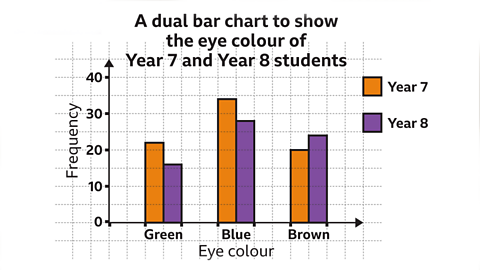
A bar chart is a type of graph used to represent a non-numericalData that is not numbers, eg, words. or discreteData that takes specific values, often whole numbers, eg, the number of siblings, shoe sizes. set of data. It uses different height rectangles, or bars, to represent the frequencyThe number of times something occurs. of each category.
It can be used to make comparisons between the categories in a set of data.
The frequency is usually represented on the vertical axisThe line on a graph that runs vertically (up-down) from the origin.. The labelling on the horizontal axisThe line on a graph that runs horizontally (left-right) from the origin. depends on what data the bar chart is representing.
A bar chart should have gaps between the bars.

Creating a bar chart
To create a bar chart data is required. The data often comes in the form of a table.
To create a bar chart:
- Look for the largest frequency in your table.
- Draw a vertical axisThe line on a graph that runs vertically (up-down) from the origin. on your square paper or graph paper.
- Choose an appropriate scale for this axis and label your axis up to the largest frequency.
- Look at how many categories are needed for the horizontal axis.
- Draw and label the horizontal axisThe line on a graph that runs horizontally (left-right) from the origin. , remembering to leave spaces for the gaps between the bars.
- Draw each bar the correct height, based on the frequencies.
- Check you have labelled each axis correctly and give your bar chart a title.
Examples
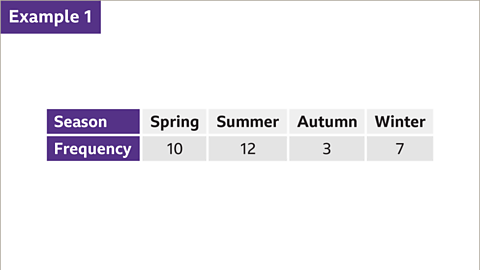
Image caption, 32 students were asked which season was their favourite. The table shows the results. Construct a bar chart that represents these results.
Image caption, To construct a bar chart first identify the largest frequency. The largest frequency is 12. The vertical axis must go up to at least 12.
Image caption, Draw the vertical axis and number it in regular intervals. In this example, the axis is increasing in increments of two. Label the axis as frequency.
Image caption, The horizontal axis requires four categories. Each bar must be the same width and gaps between the bars need to be included. Label each bar and the axis.
Image caption, Draw each bar the correct height based on the frequency. The bar for spring has a frequency of 10. The bar for summer has a frequency of 12. Using this axis requires the height of the bars showing odd numbers to be exactly between the even numbers along the vertical axis. The bar for autumn has a frequency of 3, putting it between 2 and 4 . The bar for winter has a frequency of 7, putting it between 6 and 8.
Image caption, Finally give the graph an appropriate title.
Image caption, It is possible to read data and make comparisons using a bar chart. This type of graph, called a dual bar chart, shows the eye colour of year 7 and year 8 students.
Image caption, Using the vertical axis, the frequency of each bar can be read. The axis is going up in increments of 10. Between each multiple of 10 is ten subdivisions. Each subdivision is worth 1. There are 22 students in Year 7 with green eyes.
Image caption, By adding the frequencies of the blue bars, which represent Year 7, the total number of students in that year group can be calculated. 22 + 34 + 20 = 76. There are 76 students in Year 7.
Image caption, By adding together the frequencies of two bars for each eye colour, the most frequent eye colour, the mode, can be found. Green eyes = 22 + 16 = 38. Blue eyes = 34 + 28 = 62. Brown eyes = 20 + 24 = 44. The modal eye colour for Year 7 and 8 students is blue.
1 of 10
Questions
This bar chart shows student’s favourite colour.
How many students were asked what their favourite colour was?

Number of students asked = 6 + 9 + 2 + 3 + 6 = 26
Twenty six students were asked their favourite colour.
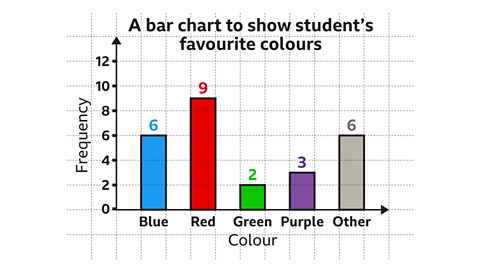
This compound bar chart shows the outcome of fixtures for four football teams for a season.
What percentage of games did Torquay United draw?
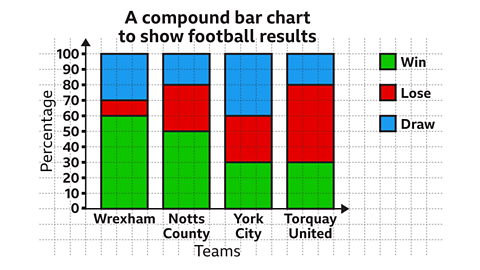
Each square in the bar represents 10%
The bar for draw, for Torquay United is two squares high.
This is equivalent to 20%
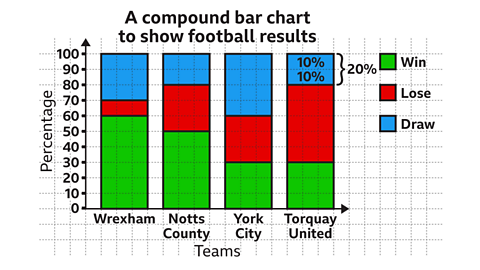
Practise working out bar charts
Practise working out bar charts with this quiz. You may need a pen and paper to help you with your answers.
Quiz
Real-life maths

A geographer A scientist who studies both the Earth's natural environment and human society. may use climate graphs to study changes in weather patterns in regions of the world. One type of climate graph shows precipitation or rainfall. This takes the form of a bar chart with the rainfall for each month being represent as a bar. The height of the bar indicates the quantity of a rainfall during that month.

Game - Divided Islands
Divided Islands. gameDivided Islands
Use your maths skills to help the islanders of Ichi build bridges and bring light back to the islands in this free game from BBC Bitesize.

More on Representing data
Find out more by working through a topic
- count2 of 6

- count3 of 6

- count4 of 6
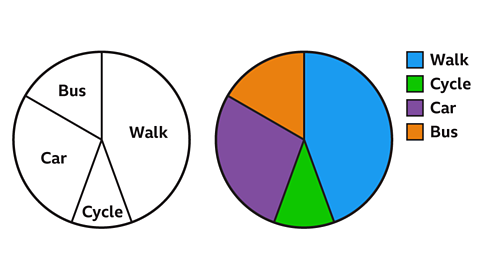
- count5 of 6
